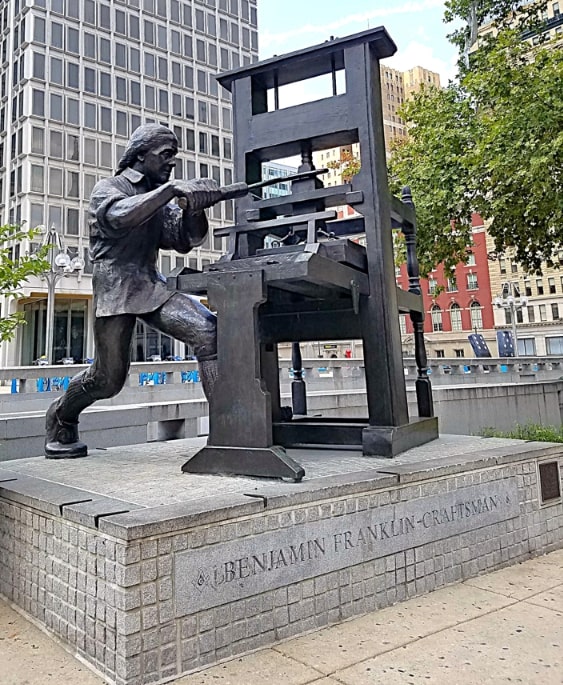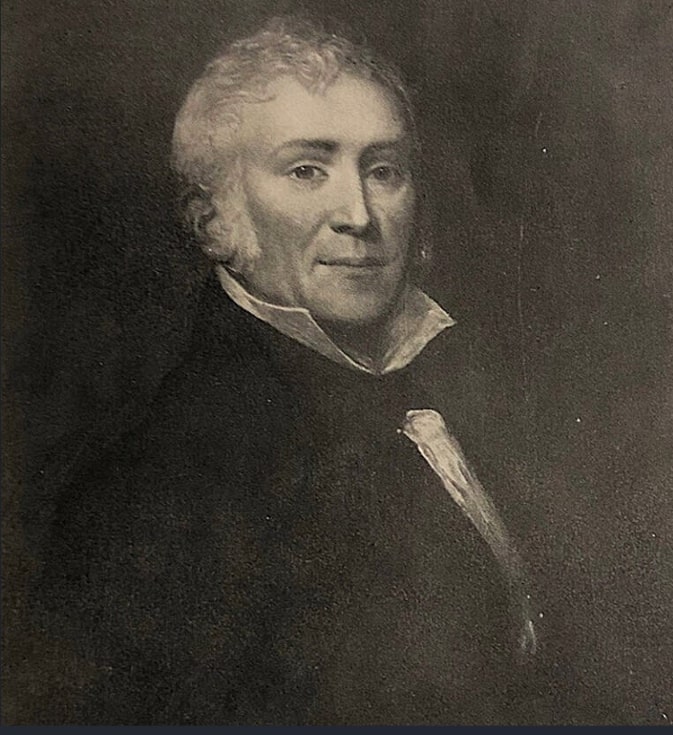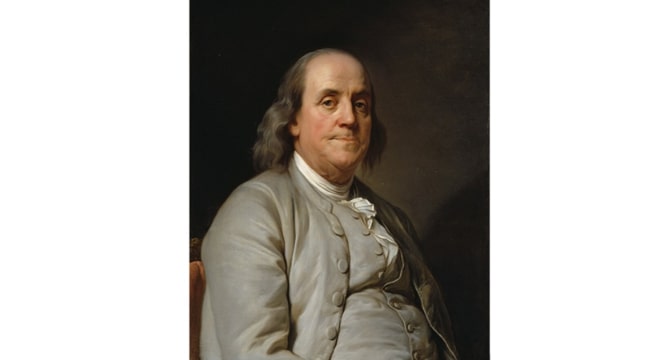Introduction: In this article, Melissa Davenport Berry writes about a colonial printer with a strong link to Benjamin Franklin, Edmund March Blunt, who lost his temper and caused a scandal. Melissa is a genealogist who has a website, americana-archives.com, and a Facebook group, New England Family Genealogy and History.
Benjamin Franklin’s (1706-1790) self-made success became a blueprint for many aspiring youths, and for the ambitious pressman he was the patron saint for all printers.
Below is a sculpture of Benjamin Franklin working on his press, by the sculptor Joseph Brown. It was a gift of the Pennsylvania Freemasons to the city of Philadelphia.

Here is a tale of one fellow printer, Edmund March Blunt (1770-1862), who emulated Benjamin Franklin’s style and possessed the same journalistic instincts that earned Franklin a spot in the annals of history among the stalwart men who helped build our nation. But Blunt earned notoriety linked to a famous tiff which he never lived down.
Edmund Blunt and the Franklin Press
Edmund March Blunt was the son of William and Elizabeth (March) Blunt and a direct descendant of Sir William Pepperell. He married Sarah Ross and left many descendants.

The printing press Franklin apprenticed on was later used by Blunt and his partner Howard Robinson at “The Sign of the Bible and the Quadrant,” located in Newburyport, Massachusetts, “six doors below from Wolfe Tavern” in 1793.
Blunt made an announcement regarding this acquisition at the New York Printers Festival:
“I have commenced a newspaper in Newburyport on a press once [used] by Franklin of which I paid 40 dollars for.”
The Impartial Herald newspaper issued by Blunt was well received. Below is a newspaper advertisement by Blunt announcing his intention to issue the Impartial Herald.
Blunt’s avant-garde style echoed Franklin’s doctrine: “Either write something worth reading or do something worth writing,” and the readers adored and relished his “broadened cultural contact” – so much so that he quashed all the competition in the area. His popular paper would eventually become the Newburyport Herald.
In 1900 a Boston Herald article reported on the Franklin press that had been used by Blunt, citing a publication from the Bostonian Society. The authenticity of the printing press came from a letter written by Mrs. Benjamin Perley Poore to William W. Warren, who purchased the Franklin relic and gifted it to the Bostonian Society.
The purpose of her letter to William Warren was to certify the provenance of the printing press before he bought it. The press had been owned by Benjamin’s brother James Franklin, and Benjamin worked on the press when he was an apprentice to his older brother. James sold the press to Edmund Blunt, who moved it to Newburyport. Mrs. Poore’s husband Benjamin bought the press when Edmund left Newburyport –
“and had it set up at Indian Hill farm, where it has been for upward of 40 years. There never has been any question as to the genuineness of the press, which Maj. [Benjamin Perley] Poore valued very highly, and steadfastly refused all offers he received for its purchase.”
Blunt and Robinson Dissolve Partnership
After less than a year of publishing the Imperial Herald, Blunt’s partner Robinson ventured alone and began publishing the Morning Star, which Blunt rubbed out almost immediately and absorbed into his newspaper. Below is a newspaper clip from the Impartial Herald of the dissolution of the publishing partnership Blunt & Robinson.
Blunt was an advertising “pioneer,” and many spectacular displays spurted from Franklin’s old press. Blunt’s hard work exhibited Franklin’s ideals: “Hide not your talents, they for use were made. What’s a sundial in the shade?” Blunt boldly spread full page ads, creating an entirely new fashion in printing.
Nautical Publications
His publishing shop also produced famous nautical texts, including The American Coast Pilot and Nathaniel Bowditch’s New American Practical Navigator. Below is an advertisement for Blunt’s publication of Bowditch’s work.
The American Coast Pilot enjoyed universal success (18 editions), and Duke Alexis of Russia dubbed it the official textbook of naval officers.
Offering meticulous details about every port along the U.S. coast, these sailing directions saved thousands from shipwreck. Thanks to such successes, Newburyport became the center of American nautical publications.
Benjamin Franklin was acquainted with Blunt through his connections with Rev. George Whitefield, but it was a mutual affinity for nautical works that firmly bonded these two men.
Franklin loved to conquer new territory – he was an Ahab for sure. He crossed the Atlantic Ocean eight times and had a deep love for nautical science. In 1769, Franklin, along with Thomas Folger, published the first chart of the Gulf Stream.
Blunt Became Known as the “Skillet Thrower” – the Skinny on the Scandal
Blunt had a notorious squabble with James Akin, an engraver he hired. According to legend, the banter between the two had many colorful accounts.
Some say Akin rubbed Blunt the wrong way, so he refused to pay the engraver – and when Akin confronted him a verbal squabble broke out in the shop of Josiah Foster on State Street.
Blunt hurled a heavy kettle pan at Akin, who managed to dodge the makeshift weapon; however, it busted through a window and walloped Capt. Nicholas Brown instead. (Read “Thomas Leavitt and His Artist Friend James Akin,” F.B. Sanborn, Granite Monthly Magazine, Vol. 25, 1898, pp. 225-234.)
Another account is mentioned in a 1952 article by antique collector Nina Fletcher Little, who asserts that it was a street brawl. She claims Blunt stopped Akins in the street to complain about his drawings and threw a skillet at him.
Whatever went down during their disagreement, Mrs. Little notes that Akin settled the score by sketching a caricature of Blunt in the heat of the crime, aptly entitled “Infuriated Despondency, a Droll Scene in Newburyport.” She says in the article:
“He sent the cartoon to England and had it used as the design on a large number of pitchers and certain other domestic vessels of less repute [chamber pots].”
When word got out that Akin’s newest cartoon decorated pitchers and chamber pots just brought to port from England, Mrs. Little claims that “a group of Blunt’s friends raided the vessel and broke all the pieces they could find.” However, a few survived and are displayed in museums today.
Rather than show his ire, Blunt should have heeded Ben’s wisdom:
“Love your enemies, for they tell your faults” and “Whatever is begun in anger ends in shame,” because the incident sadly caused Blunt to move on to calmer seas in New York.
Frankly, any tip from Ben is priceless: “Do not squander time, for that is the stuff life is made of.” “If you lie down with dogs, you get up with fleas.” “A penny saved is a penny earned!”
Explore over 330 years of newspapers and historical records in GenealogyBank. Discover your family story! Start a 7-Day Free Trial
Note on the header image: Benjamin Franklin, by Joseph-Siffred Duplessis, c. 1785. Credit: National Portrait Gallery; Wikimedia Commons.
